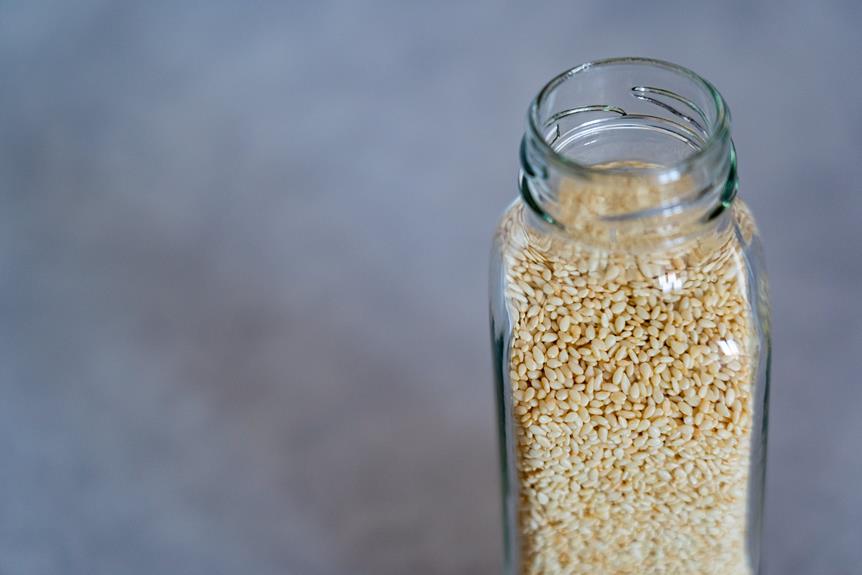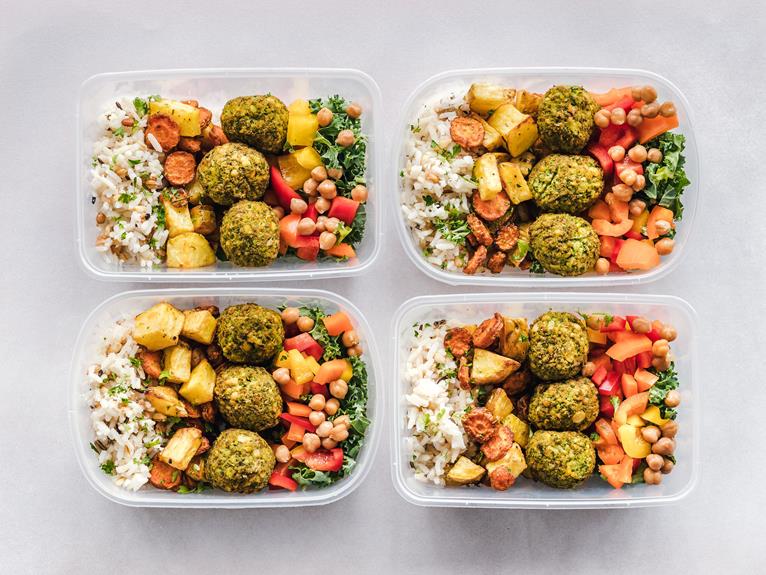With the increasing popularity of low-carb diets for weight management and health improvement, meal planning has become a crucial aspect of adhering to this dietary lifestyle.
By strategically organizing meals that are low in carbohydrates, individuals can experience improved energy levels, better blood sugar control, and weight loss.
This discussion aims to provide you with practical tips and strategies for meal planning on a low-carb diet, so you can take charge of your health and achieve your wellness goals.

Benefits of a Low-Carb Diet
When following a low-carb diet, you can expect to experience numerous benefits that will positively impact your overall health and well-being. One of the most significant benefits is weight loss. By reducing your intake of carbohydrates, your body is forced to burn stored fat for energy, leading to a gradual and sustainable weight loss.
A low-carb diet can help improve blood sugar levels. When you consume fewer carbs, your body requires less insulin to regulate blood sugar, resulting in more stable and balanced glucose levels.
Another advantage of a low-carb diet is increased energy. When you limit your intake of carbohydrates, your body becomes more efficient at using fat as fuel. This can lead to a steady and consistent supply of energy throughout the day, without the crashes often associated with high-carb meals.
Furthermore, a low-carb diet can help reduce cravings for sugary and processed foods. By eliminating or minimizing these foods, your taste buds adjust, and you become less reliant on unhealthy snacks.
Better digestion is another benefit of a low-carb diet. By cutting back on carbohydrates, you may experience fewer digestive issues such as bloating, gas, and indigestion. This is because low-carb foods tend to be higher in fiber, which promotes a healthy gut and regular bowel movements.
Understanding the Basics of a Low-Carb Diet
To understand the basics of a low-carb diet, it’s important to familiarize yourself with the principles and guidelines that define this dietary approach.
A low-carb diet is characterized by reducing the intake of carbohydrates and increasing the consumption of protein and healthy fats. By doing so, it helps stabilize blood sugar levels, promote weight loss, and improve overall health.
There are numerous benefits to following a low-carb diet. Research has shown that it can lead to weight loss, reduce the risk of heart disease, improve insulin sensitivity, and lower inflammation levels in the body. Many individuals have reported increased energy levels, improved mental clarity, and reduced cravings for sugary foods.
However, there are also some misconceptions surrounding low-carb diets. Some people believe that it means eliminating carbohydrates, which isn’t the case. It’s about making healthier choices and consuming complex carbohydrates in moderation. It’s also important to note that not all carbohydrates are created equal, and opting for whole, unprocessed foods is key.
When planning meals on a low-carb diet, focus on incorporating lean proteins, vegetables, and healthy fats. Some meal ideas include grilled chicken with roasted vegetables, salmon with a side of avocado and spinach salad, or a stir-fry with tofu and a variety of colorful veggies.
Lastly, there are countless success stories from individuals who’ve found great results with a low-carb diet. They haven’t only achieved their weight loss goals but have also experienced improvements in their overall health and well-being.
Setting Your Low-Carb Diet Goals
As you embark on your low-carb diet journey, it’s crucial to establish clear and attainable goals that will guide your dietary choices and help you achieve the desired outcomes. Goal setting is an essential part of any successful journey, as it provides you with a sense of direction and purpose.
Start by setting specific goals that are measurable and realistic. For example, you can aim to reduce your daily carbohydrate intake to a certain amount or lose a specific amount of weight within a set timeframe.
To track your progress, consider keeping a food diary or using a mobile app to log your meals and snacks. This won’t only help you stay accountable but also give you valuable insights into your eating habits.
Celebrate your achievements along the way to stay motivated, whether it’s reaching a weight loss milestone or successfully resisting temptation at a social gathering.
Overcoming challenges is an inevitable part of any journey, and your low-carb diet is no exception. When faced with obstacles, remind yourself of why you started and focus on the positive changes you’ve already made.
Adjusting your meal plan may be necessary to accommodate your goals and preferences. Take the time to experiment with different recipes and food choices to find what works best for you.
Assessing Your Current Eating Habits
Start by evaluating your current eating habits to identify areas where you can make changes to align with your low-carb diet goals. Evaluating portions is a crucial step in understanding your current eating habits.
Take note of how much you eat at each meal and snack. Are you consuming larger portions than necessary? Are you eating mindfully or rushing through your meals?
Analyzing nutrient intake is also important. Are you getting enough protein and healthy fats? Are you consuming too many carbohydrates?
Identifying trigger foods is another aspect to consider. These are the foods that may tempt you to veer off track from your low-carb diet. By recognizing these trigger foods, you can find alternative options or strategies to avoid them.
If you feel overwhelmed or unsure about making changes to your eating habits, consider seeking professional guidance. A registered dietitian can provide personalized advice and support.
Identifying Low-Carb Food Options
Evaluate the nutritional content and carbohydrate levels of various foods to identify low-carb options that align with your diet goals. When it comes to following a low-carb diet, it’s important to choose food options that aren’t only delicious but also fit within your dietary restrictions.
Whether you’re looking for low-carb snack options, low-carb breakfast ideas, low-carb lunch recipes, low-carb dinner options, or even low-carb dessert alternatives, there are plenty of choices available to keep you satisfied throughout the day.
For snacks, consider options like nuts, seeds, or sliced vegetables with a low-carb dip. These can provide a satisfying crunch while keeping your carb intake in check.
When it comes to breakfast, try incorporating high-protein foods like eggs, Greek yogurt, or lean meats into your meals. These can help keep you feeling full and energized throughout the morning.
For lunch and dinner, focus on lean proteins such as chicken, fish, or tofu, paired with non-starchy vegetables like broccoli, spinach, or cauliflower. These low-carb options can provide you with the necessary nutrients while keeping your carb intake low.
And for those with a sweet tooth, consider low-carb dessert alternatives like sugar-free jello, berries with whipped cream, or dark chocolate.
Planning Your Low-Carb Meals for the Week
To effectively plan your low-carb meals for the week, consider incorporating a variety of protein-rich foods and non-starchy vegetables into your menu. This won’t only provide you with essential nutrients but also help you stay satisfied and energized throughout the day.
Planning your meals ahead of time has numerous benefits, such as saving time and money, and making it easier to stick to your low-carb diet. Here are some tips and tricks to help you plan your low-carb meals for the week:
- Benefits of meal planning: Meal planning allows you to have control over your food choices, ensuring that you stay on track with your low-carb diet. It also helps you avoid impulsive food decisions and reduces the risk of reaching for unhealthy options.
- Easy low-carb recipes: Look for simple and delicious recipes that are low in carbohydrates. There are plenty of resources available online that offer a wide range of ideas for low-carb meals.
- Time-saving meal prep: Dedicate a specific time each week to meal prep. This will save you time during busy weekdays and make it easier to stick to your low-carb plan.
- Budget-friendly options: Opt for budget-friendly ingredients such as eggs, chicken, and seasonal vegetables. Buying in bulk and planning your meals around sales and discounts can also help you save money.
Creating a Grocery Shopping List for Your Low-Carb Diet
When creating a grocery shopping list for your low-carb diet, it’s important to prioritize nutrient-rich foods that align with your dietary goals. By carefully planning your meals and organizing your shopping, you can stay on track and make healthier choices. Here are some grocery shopping tips and meal planning strategies to help you succeed:
| Grocery Shopping Tips | Meal Planning Strategies |
|---|---|
| 1. Make a list before you go to the store. | 1. Plan your meals for the week ahead. |
| 2. Stick to the perimeter of the store where fresh produce, meat, and dairy are located. | 2. Include a variety of low carb recipe ideas in your meal plan. |
| 3. Look for budget-friendly options like frozen vegetables or buying in bulk. | 3. Prep your meals in advance to save time and stay on track. |
| 4. Read food labels to identify hidden carbs and choose products with lower carb counts. | 4. Opt for whole foods instead of processed or packaged foods. |
| 5. Buy in-season produce for freshness and affordability. | 5. Experiment with meal prep hacks to simplify your cooking process. |
Preparing and Cooking Low-Carb Meals
To successfully prepare and cook low-carb meals, focus on utilizing fresh ingredients and incorporating innovative cooking techniques. Here are some preparation techniques and cooking tips to help you create delicious and satisfying low-carb meals:
- Roasting and grilling: These cooking methods bring out the natural flavors of vegetables, meats, and fish without adding unnecessary carbs. Try roasting some low-carb vegetables like cauliflower or grilling a juicy steak for a hearty meal.
- Stir-frying: Stir-frying is a quick and easy way to cook low-carb meals. Use a non-stick pan and a small amount of oil to sauté your favorite vegetables with lean protein sources like chicken or tofu.
- Substituting ingredients: Experiment with ingredient substitutions to make your favorite recipes low-carb-friendly. Replace traditional pasta with zucchini noodles or spaghetti squash, and swap out flour with almond or coconut flour for baking.
- Time-saving strategies: Plan your meals ahead of time and prep ingredients in advance to save time during the week. Cook large batches of protein and portion them out for easy meal assembly later on.
With these recipe ideas, preparing techniques, cooking tips, and time-saving strategies, you can confidently create a variety of flavorful low-carb meals. Remember to stay creative and have fun in the kitchen while enjoying the benefits of a low-carb diet.
Incorporating Variety Into Your Low-Carb Meal Plan
Incorporating variety into your low-carb meal plan allows you to explore different flavors and textures while still staying on track with your health goals. When it comes to low-carb cooking, there are plenty of variety options to keep your taste buds satisfied.
To add excitement to your meals, try experimenting with different recipe ideas that incorporate a range of ingredients. Meal prep can also help you achieve variety in your meals. Spend some time on the weekend to prepare different proteins, vegetables, and grains that can be easily combined throughout the week.
Flavor combinations are key to keeping your taste buds engaged. Don’t be afraid to experiment with different herbs, spices, and condiments. They can add a burst of flavor to any dish.
Ingredient substitutions can help you introduce new tastes and textures into your low-carb meal plan. For example, if you usually use cauliflower rice, try swapping it out for spiralized zucchini or shirataki noodles.
Remember that variety is the spice of life, and it’s no different when it comes to your low-carb meal plan. By exploring different flavors, textures, and ingredients, you can keep your meals exciting and satisfying while still maintaining your health goals.
Meal Prepping for a Low-Carb Diet
Prepare your meals in advance to save time and stay on track with your low-carb diet. Meal prepping is a great way to ensure that you have healthy and delicious meals ready to go throughout the week.
Here are some meal prep tips to help you succeed:
- Plan your meals for the week: Take some time to sit down and create a meal plan for the upcoming week. This won’t only save you time but also help you make healthier choices by avoiding impulsive decisions.
- Look for low-carb recipes: There are plenty of delicious low-carb recipes available online. Look for recipes that are easy to prepare and can be made in large batches, so you can portion them out for the week.
- Use time-saving strategies: To save even more time, consider using time-saving strategies such as batch cooking or using a slow cooker. These methods allow you to prepare multiple meals at once, cutting down on your overall prep time.
- Meal prep on a budget: Eating a low-carb diet doesn’t have to be expensive. Look for affordable ingredients and plan meals that use ingredients that are in season or on sale. You can also buy in bulk and freeze leftovers for future meals.
Tips for Dining Out on a Low-Carb Diet
If you’re following a low-carb diet and find yourself dining out, here are some helpful tips to navigate the menu while staying on track with your goals. It can be challenging to make healthy choices when dining out, especially when faced with tempting menu options and social gatherings. However, with a little preparation and knowledge, you can still enjoy dining out without derailing your low-carb lifestyle.
One way to make dining out easier is to research the restaurant’s menu choices beforehand. Many restaurants now offer online menus, making it easier to find low-carb options. Look for dishes that are centered around lean proteins like chicken, fish, or steak, and ask for any sauces or dressings on the side.
Another tip is to navigate desserts wisely. It’s okay to indulge occasionally, but it’s important to make smart choices. Opt for a small serving of fresh berries with whipped cream instead of a high-carb dessert. Alternatively, you can choose a sugar-free option if available.
When it comes to ordering drinks, be mindful of hidden sugars. Avoid sugary cocktails, sodas, and juices. Instead, opt for unsweetened iced tea, sparkling water with a splash of lemon or lime, or a glass of dry red or white wine.
Remember, dining out doesn’t have to mean sacrificing your low-carb lifestyle. By researching dining options, making smart menu choices, navigating desserts, and ordering drinks wisely, you can enjoy dining out while staying on track with your goals.
| Tips for Dining Out on a Low-Carb Diet | |
|---|---|
| Research the menu beforehand | Find low-carb options centered around lean proteins like chicken, fish, or steak. Ask for sauces and dressings on the side. |
| Make smart dessert choices | Opt for fresh berries with whipped cream or sugar-free options if available. |
| Order drinks wisely | Avoid sugary cocktails, sodas, and juices. Choose unsweetened iced tea, sparkling water with lemon or lime, or a glass of dry wine. |
Overcoming Challenges and Staying Motivated on a Low-Carb Diet
Staying motivated on a low-carb diet can be a challenge, but with the right mindset and strategies, you can overcome obstacles and reach your health and wellness goals.
It’s important to remember that cravings are normal and can sometimes make it difficult to stay on track. However, there are ways to deal with cravings and stay motivated. Here are some tips to help you along the way:
- Stay consistent: Stick to your low-carb meal plan even when you feel tempted to indulge in high-carb foods. Consistency is key to long-term success.
- Find support: Surround yourself with a supportive community or join a low-carb group where you can share your journey, get advice, and find motivation from others who are facing similar challenges.
- Meal planning tips: Plan your meals to avoid making impulsive food choices. Create a weekly menu and make a shopping list to ensure you have all the ingredients you need for your low-carb meals.
- Stay positive: Remember why you started this journey in the first place. Focus on the benefits of a low-carb diet, such as improved energy levels, weight loss, and better overall health. Celebrate your progress and reward yourself for reaching milestones.
Tracking Your Progress and Adjusting Your Meal Plan
Now that you’re maintaining your motivation on a low-carb diet, it’s important to track your progress and make necessary adjustments to your meal plan.
Tracking your progress allows you to measure your success and monitor the results of your efforts. It provides you with valuable information about what’s working and what needs to be changed.
One way to track your progress is by keeping a food diary. Write down everything you eat and drink each day, along with the portion sizes. This will help you see patterns and identify any areas where you may be consuming too many carbs.
You can use a fitness app or a spreadsheet to track your daily carbohydrate intake. This will give you a clear picture of how many carbs you’re consuming and if you need to make any adjustments to your meal plan.
As you track your progress, it’s important to also listen to your body and adapt your strategy accordingly. Pay attention to how you feel after certain meals and make note of any changes in your energy levels or weight.
If you’re not seeing the results you desire, it may be time to adjust your meal plan. This could involve reducing the portion sizes of certain foods, increasing your intake of protein and healthy fats, or incorporating more low-carb vegetables into your meals.
Conclusion
Meal planning for a low-carb diet may seem daunting at first, but with the right mindset and a little preparation, you can conquer any challenge that comes your way.
Remember, staying motivated and tracking your progress is key to success. And who knows, maybe one day you’ll even find yourself craving those low-carb options instead of the carb-loaded temptations.
It’s ironic how our tastes can change when we give our bodies what they truly need.













